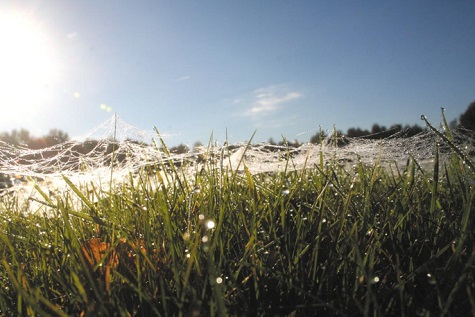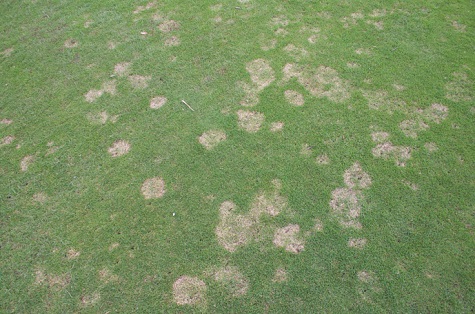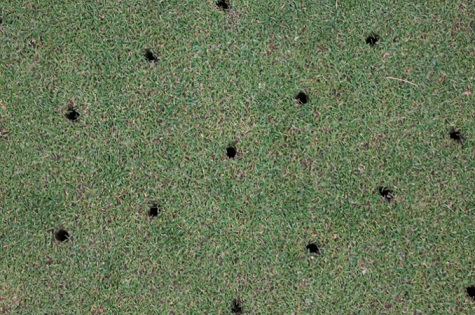It has been a busy couple of weeks for most cricket clubs up and down the country, trying to get their end of season renovations completed before the weather breaks - which is what happened last weekend.
After several weeks of sunny weather, a new weather front moved in bringing with it some heavy downpours - not what you want when you just top dressed and seeded your square.
However, that said, with ground conditions being so dry, this change in the weather will be a welcome relief for many turf professionals who want to get any seed sown to germinate whist soil and air temperatures remain in double figures. These warm and wet conditions will help promote some final growth before the winter sets in. However, it may also promote some outbreaks of disease.

Dew removal
Recently we have seen evening air temperatures dropping dramatically, especially when there are clear cloudless nights, resulting in heavy morning dews on our playing surfaces.
This combination of early morning dews, warm and wet weather and diminishing daylight hours increases the risk of fungal disease outbreaks.
The three disease factors: susceptible grass / host, pathogen, and environment, provide the evidence for disease diagnosis. Symptoms are the expression of the susceptible grass to the disease and can take on a variety of forms.

Symptoms may appear on the leaves as small, circular, tan-coloured lesions surrounded by brown or purple borders (leaf spotting); as yellow, red, or tan blotches over most or all of the leaf blade (blighting); stunting; wilting; or as a brown or black rot on the crowns and roots. The appearance of these symptoms will also vary depending on the type of disease, the severity of the attack and the developing stage of the disease.
Early identification of the symptoms is essential for good disease management; however, the best form of management is using preventive, cultural turf maintenance methods that reduce the ideal environmental factors that these diseases require for development.

Therefore, a programme of regular brushing/switching of the grass to remove excess moisture, regular aeration to allow gaseous exchange and water percolation.
We have, over the years, developed many methods of removing dew from playing surfaces. I remember the times I spent dragging hose pipes over the Fratton Park pitch. I also remember using switch canes to remove dew off bowling and golf greens. However, these laborious tasks have been superseded with the development of brushing attachments that can be fitted to both mowers and utility vehicles to speed up operations. Hand switching does also give you an opportunity to get close and personal and keep an eye on what’s happening though.

Other cultural methods to help reduce disease pressure would be removal of thatch (which harbours pathogens), by verti-cutting and end of season renovations - as well as checking mower blades are sharp to provide a precise cut of the leaf blade and reduce the potential for disease.
Disease identification
Identification of these diseases can sometimes be difficult in the early stages of attack. It’s often only possible to recognise the type of disease when the fruiting bodies of the disease produce structures such as spores, mushrooms, or mycelium (small, thread-like filaments produced by fungi) that can be seen without the aid of a microscope. A good example of this is Red Thread (Laetisaria fuciformis) where the distinctive red filaments can be seen amongst the grass.

Site characteristics and turf management practices have a large influence on disease management. Factors such as air movement, drainage, soil conditions, and the amount of sun or shade, slope, fertilisation, and aeration programmes are important in influencing the development of turf diseases.
It is important to remember that pathogenic fungi can survive and remain in a dormant state in plant debris and soil until favourable conditions arrive again to stimulate another disease outbreak.
The Pathogens that cause these diseases are always around lying dormant in the thatch layers waiting for the ideal conditions to become active. Once these spores are activated and have found an appropriate host, they are able to grow and reproduce themselves, spreading new spores and infections to other areas of turf. This cycle continues whilst favourable conditions prevail.
Understanding the disease cycle and implementing works that can break up the disease cycle will help reduce the opportunities for disease development and outbreak.
When it comes to disease identification, there is as much emphasis on you as the turf manager to provide appropriate turf samples for analysis as there is for the lab to accurately identify the problem. In most cases, the best place to remove a turf sample for analysis is from the leading edge of the symptoms, where the affected or discoloured plants give way to healthy turf.
It is also important for the lab to be able to see what the general composition and condition of the sward is like and what the rootzone profile is like and, for those reasons, a 90mm diameter core sample, taken to a depth of approximately 60mm using a golf hole changer (or similar) makes for an ideal sample.
If possible, email some photographs of the symptoms so that the lab can get an idea of how the problem is developing - a good picture can often tell so much more than a detailed written description.
There are several excellent laboratories that offer disease recognition, along with some good weather services that offer disease watch forecasts. One I reccommend is Syngenta’s Greencast service.
Common Diseases that can be active and cause concerns at this time of the year are :- Red Thread, Fusarium and Dollar spot.
With the limited availability of fungicide products now on the market, we now have to look at a range of other Integrated Pest management (IPM) strategies to help prevent the outbreak of pests and diseases.